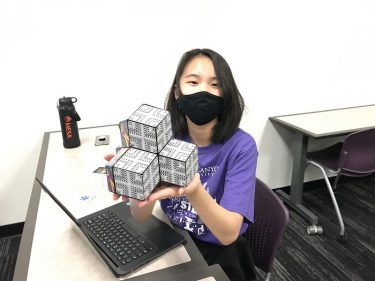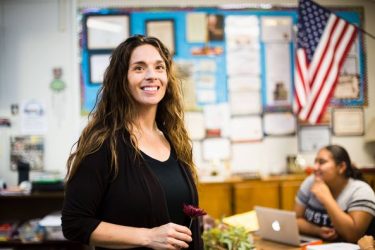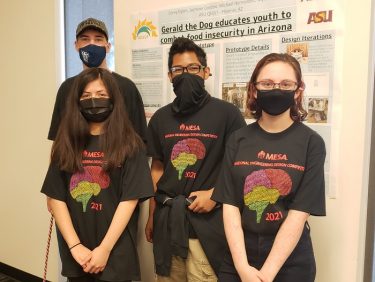
By Lana Sweeten-Shults
GCU News Bureau

“It’s showtime,” a pumped-up Mia DeLaRosa bellows Monday morning as she approaches Fiona Tran.
Tran, who just wrapped up her eighth-grade year at Sevilla Elementary School West, is at the ready, her laptop fired up in Grand Canyon University’s Engineering Building. She’s just a minute away from her virtual presentation in the MESA USA National Engineering Design Competition. It’s the first time Sevilla West has made it to the nationals.
In the adjacent room, the high school ASU QESST team (pronounced "quest"), whose roots are also at Sevilla West, feels the same electricity. The students' nerves are on high as they, too, wait for the “Go!” to begin their presentation in the same national competition.
“Just say your name and you’ve got 10 points,” says DeLaRosa, the STEM educator at Sevilla West, sensing Tran’s nerves and helping build her confidence.
“Remember, you know everything; they know nothing,” GCU K12 STEM Outreach Manager Marni Landry pipes in, fluffing Tran’s confidence even more.
Then it is definitely showtime: “Hi. I’m Fiona Tran. Our project is called Light at Night …”
Partnering in the STEM cause

It was in 2017 when Landry and her GCU STEM cohort, K12 STEM Outreach Director Cori Araza, saw an opportunity.
MESA USA's previous university partner in central Arizona dropped out, and with GCU having just launched its engineering program in 2015 (and opening the new Engineering Building in 2016), the University's K12 STEM Outreach team was more than excited to take up the MESA mantle.
The school outreach program — it stands for Mathematics, Engineering, Science Achievement — engages tens of thousands of educationally disadvantaged students across the country in math and science through classes, counseling, career path exploration and competitions. The hope is that they’ll graduate with math-based degrees and that those educationally disadvantaged students will become scientists, engineers and mathematicians.
GCU has the same vision when it comes to STEM education.
“It’s supporting our community,” said Landry. “MESA specifically is targeted at underserved youth and underserved populations. The No. 1 mission is to get students who are not represented in STEM fields — engineering fields — to have that experience so they have the confidence. We find that students have the interest, but if they haven’t been exposed to it, they don’t have the confidence to move forward.”
GCU wants to instill that confidence, particularly in students from the disadvantaged neighborhoods around the University — neighborhoods GCU has dedicated itself to serving as part of its Christian mission.
GCU has supported the surrounding community not only through MESA USA, but through partnerships with organizations such as Habitat for Humanity to renovate homes in the Canyon Corridor and through initiatives such as Students Inspiring Students, which awards full-tuition neighborhood scholarships to students much like those at Sevilla West.

Landry and Araza have served as mentors to campuses in the Alhambra Elementary School District, including Sevilla West, which sits about a half-mile from GCU. They coach teams and have offered workshops throughout the year.
And they’re not the only ones.
“Cori is really good at finding a GCU student to pair up with the student teams,” Landry said.
“I cannot understate, when people say that I couldn’t do it without them, it tends to be cliché, but this is no cliché,” Sevilla West’s DeLaRosa said of the support she receives from parent volunteers and fellow educators such as the team at GCU. The University introduced her students to engineering through a potato bridge building project a few years ago and has sent GCU students to her classrooms. “It’s just been a really great relationship over the years − Cori and Marni and Professor (Kevin) Williams over in Engineering. They have all just been very supportive of us.”
"Designing for Equity"

That support paid off with not just one but two Sevilla West teams ascending to the national level of competition in the middle of a pandemic. The high school team, since it could not compete the previous year because of COVID-19, was invited to compete this year.
The competition, called “Designing for Equity,” asked students to identify an individual or group that experiences inequity. Then, using a microprocessor as the key component of the design, teams were tasked with coming up with a solution that employed human-centered design practices. Teams were required to use Arduino, Circuit Playground Express or Micro:bit microprocessors.
Tenth grader Jazmine Cordon’s journey with MESA USA began more than a year ago. In February 2020, she debuted her middle school MESA project with her best friend, Keily Barrios, at the central regional competition on the GCU campus.
Barrios loves plants, Cordon loves cats and cute things, and they combined their two interests. The result: a plant-watering robot made to look like a cat.
It is programmed in the computer language C++ using an Arduino board and is able to read inputs – a moisture sensor, in this case – and turn those inputs into an output (the release of water).
But before the state and national competitions could roll around, the pandemic hit.
That once-in-a-lifetime, yearlong interruption in normal daily life turned out to be fortuitous for the ASU QESST team and Director and team sponsor Dr. Michelle Jordan from Mary Lou Fulton Teachers College.
“We got to refine everything and improve the project,” said team member Michael Hernandez, who worked on the plant-watering robot alongside Cordon, Myla Dykes and Corey Dykes. The team changed the robot’s design, its user focus and had the chance to do more research.

“We wanted to address global warming and food insecurities,” Cordon added of solving an inequity in the world.
One change was turning the robot’s interface with humans from a cat to a dog, dubbed Gerald. Research revealed that the middle school audience the team was trying to reach with this project preferred dogs over cats.
The objective is to help students in grades four to eight grow their own vegetables in a fun and simple way, which in turn will empower those young green thumbs to develop healthier eating habits.
“The team has honestly poured so many hours into working on it, so I think we’re all fairly proud of ourselves to come this far,” said Cordon.
She added of GCU’s support: “They stepped in by giving us a space where we feel comfortable, and there are people around who want to help us.”
The other Sevilla West team, sponsored by the Alhambra Elementary School District, wanted to help wheelchair users, so it designed a light specifically for wheelchairs. The idea was to help extend a wheelchair user’s day and make it safer to get around at nighttime.
Tran, who worked on the project with Hanna Allen, said wheelchairs do some amazing things. But surprisingly, they didn’t find much in their research on wheelchair lights.
“It was such a simple solution,” Tran said. “You would think it would be out somewhere already. You have wheelchairs that walk up stairs, wheelchairs you can use on uneven terrain, but no.”
Of her virtual talk with judges, she said, “This project opened our eyes to the life of a person with disabilities.”
Those are the kinds of experiences and realizations educators such as DeLaRosa, Landry and Araza hope students have.
While the GCU-supported Sevilla West teams learned on Tuesday that they did not place in the competition, they made huge strides just getting to the national stage during such a challenging time.
“You find the failure and give it a hug,” DeLaRosa said.
It’s a life lesson she often conveys to her students.
Translation: You learn from failure, and then you get better.
“We’re going to continue to do this. Having future GCU students and staff involved is so powerful,” Landry said of the educational investment in the community. “It’s a really easy way to give back and to mentor students – zero to little effort. Just be present.”
GCU senior writer Lana Sweeten-Shults can be reached at [email protected] or at 602-639-7901.
***
Related content:
GCU Today: Students make the circuit at MESA regionals
GCU Today: GCU engineering event was no small potatoes















